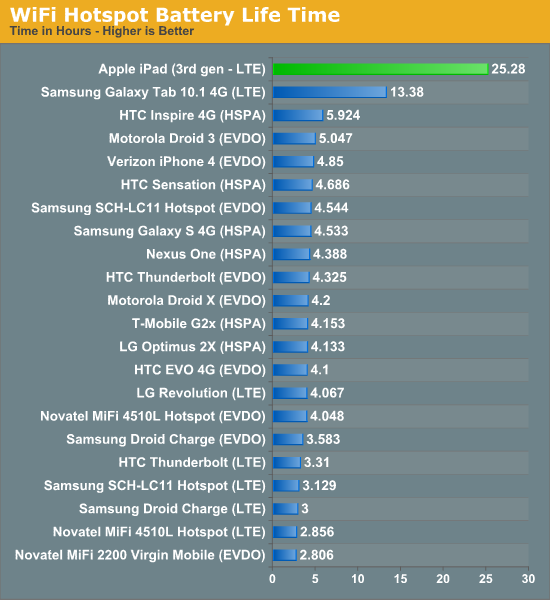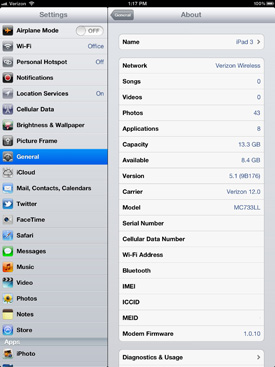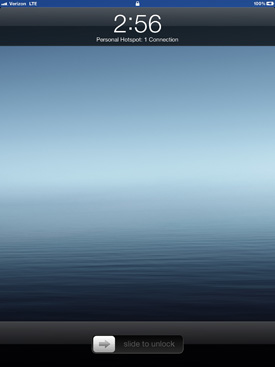The Apple iPad Review (2012)
by Vivek Gowri & Anand Lal Shimpi on March 28, 2012 3:14 PM ESTThe iPad as a Personal Hotspot: Over 25 Hours of Continuous Use
Verizon makes the decision of which iPad to buy even more difficult by being the only of the two US carriers to enable the personal hotspot option on the new iPad. For no additional monthly fee on top of your data plan your Verizon LTE iPad can act as a wireless hotspot, allowing up to five other devices to use its cellular connection over WiFi (2.4GHz only, unfortunately) or Bluetooth. One device can use the hotspot via the iPad's USB dock cable.
If you don't already have the personal hotspot option in the initial settings page, you'll need to go to general settings, then network, and activate personal hotspot there. Once you've done so you'll see a new item for personal hotspot in the default settings page.
You must remain on the personal hotspot settings page for the iPad's SSID to be visible to nearby devices. Once you leave the settings page, the iPad stops broadcasting its personal hotspot SSID.
In general the iPad's personal hotspot seems to be better behaved than similar options under Android. I've noticed all too often that Android hotspots will either stop routing traffic after an extended period of use, requiring either cycling the radio states on the hotspot device itself or in some cases a full reset of the hardware. The iPad wasn't immune to this sort of behavior, it just seemed to happen less than on the Android tablets and smartphones that I've tested. In one test it took only a few hours before I had to reset the iPad to make its hotspot work properly again, while in another case it was only after 24 hours of continuous use that the feature began misbehaving. Overall I am very pleased with the Verizon iPad as a personal hotspot, the bigger issue is the cost of the data that you're sharing with all of those devices.
As I mentioned in our Galaxy Tab 10.1 LTE review, these LTE tablets make great hotspots simply because you are pairing smartphone modems with gigantic (for a smartphone) batteries. The end result is if you have to treat your LTE tablet as a true hotspot (screen off and all), you get great battery life. The new iPad takes this idea to a completely new level since its battery is now squarely in the laptop-sized category, but its LTE modem is still designed to run on a < 6Wh smartphone battery.
Our standard hotspot battery life test involves running four copies of our web browsing battery life test and playing a 128Kbps internet radio stream on a laptop tethered via WiFi to the hotspot being tested. While peak download speeds during this test can reach as high as 1MB/s, remember that these web browsing battery life scripts include significant idle time to simulate reading a web page. The average data transferred over the duration of the test amounts to around 25KB/s if you take into account idle periods.
With the Galaxy Tab 10.1 LTE I tried something different—letting the tethered notebook download at full speed using the Tab's LTE connection. On the new iPad, after nearly an hour of downloads at well over 1MB/s I saw no drop in the battery percentage indicator—it was stuck at 100%. Not wanting to upset Verizon too much, I needed to find a good balance between a realistic workload and something that wasn't going to make me rack up over a hundred GB in overages.
If our standard hotspot test averages around 25KB/s of transfers, I figured doubling it couldn't hurt. I downloaded a sufficiently large file at a constant 50KB/s on a laptop tethered over WiFi to the new iPad to see how long it would last. The result was astounding: 25.3 hours on a single charge

I used up over 4.5GB during this period—almost the entire amount that my $50/month plan gave me, all without having to plug the iPad in to recharge it. That's the beauty of using a 42.5Wh battery to drive a cellular modem that can last a couple of hours on a tenth of that capacity. If you want to use the new iPad as a personal hotspot, you'll likely run out of data before you run out of battery life.
It's a real shame that AT&T decided against enabling personal hotspot on its version of the LTE iPad. It's for this reason alone that I'd recommend the Verizon version, assuming that you're planning on using your iPad in an area where Verizon has LTE coverage of course.












234 Comments
View All Comments
Jamezrp - Wednesday, March 28, 2012 - link
Didn't want to cause Verizon too much trouble? Heh, very funny. I am amazed at how the iPad ends up being an amazingly good Wi-Fi hotspot. It almost seems like business users should opt to get an iPad for that function alone. I know plenty of people who would be happy to keep it in their bag, with the hotspot feature enabled constantly, while travelling about. Even for the price there is nothing even close that can compare.Plus, you know, you get the tablet too.
supertwister - Wednesday, March 28, 2012 - link
"It’s a quantum leap from the noisy, 0.7MP mess that was the iPad 2 camera."Interesting choice of word considering a quantum is the smallest possible division for a quantity...
omion - Wednesday, March 28, 2012 - link
Quantum leap:(n) an abrupt change, sudden increase, or dramatic advance
The phrase comes from the ability of particles to make a sudden jump between two energy levels. It is a leap (of any amount) between two quantization levels, not a leap of the smallest possible amount.
drwho9437 - Wednesday, March 28, 2012 - link
A large fraction of the die doesn't seem to have a known use? Wondering what could be taking up all that area if not GPU, CPU and memory interfaces/caches... Most other I/O would have small footprints...tipoo - Wednesday, March 28, 2012 - link
The 4S had a larger than usual die for its voice cancellation features that were needed to make Siri work well, the iPad does't have that but it does have voice dictation so some space is probably for that.PeteH - Wednesday, March 28, 2012 - link
A big chunk of it is probably the ISP they talked about when the 4S debuted.Lucian Armasu - Wednesday, March 28, 2012 - link
So this is how I assumed. The new iPad is in fact slower than the iPad 2, if games actually start using the 2048x1536 resolution for their apps, which everyone seems to be encouraging them to do. But once they do that the graphics will either look poorer, or they will be slower than they were on the old resolution, even on an iPad 2.Add that to the fact that apps are much bigger in size with the retina resolution, and the CPU is the same as last year. The new display might look great, but it's obvious that the new iPad is absolutely a step-back in terms of performance, whether it's GPU or CPU we're talking about. Hardly worth an upgrade, especially for iPad 2 owners.
xype - Thursday, March 29, 2012 - link
Blah blah blah performance blah not worth it.I don’t give a shit about theoretical performance that I might be getting if DNA folding software was available for tablets. I really, really give a shit about being able to read website and ebook text without my eyes straining after an hour.
One would think that 10 years after "No wireless. Less space than a nomad. Lame." and Apple raking in millions and billions of profit, those Geek Metrics™ that people are so fond of here (nothing wrong with that, it’s interesting stuff!), would be recognized as completely and utterly worthless to the average population. But apparently not.
The iPad was never ment to replace PCs and Consoles as a hardcore gaming device, and it was never ment as a render farm server replacement. It would be really nice if people realized that, at some point. In the next 5 years, perhaps.
tipoo - Thursday, March 29, 2012 - link
It seems a bit like the 3GS-4 transition, it used the same GPU despite higher resolution and so performed worse at native, although in this case the CPU is unchanged and the GPU is "only" 2x better for 4x the pixels. Developers got around that on the 4 by making games for the old resolution and using upscaling mode. I'd imagine they will do the same here once games hit the limits of the GPU at native. Games like Infinity Blade 2 also use separate resolutions for things like the menus vs shadows vs terrain textures.darkcrayon - Thursday, March 29, 2012 - link
I guess if the only thing you bought an iPad for were games, and you could only consider a game to be worthwhile if it were drawn directly at 2048x1536, you'd have a point. But of course the new iPad could play games at the "iPad 2" resolution at much higher detail, or at a slightly resolution with the same detail, etc.It doesn't make sense to say it's a step backward in performance overall- it simply has the option to display much higher resolution graphics that the old model didn't have. The iPad 2 displays 2048 x 1536 text at "0 mhz" so to speak. It's not like you are losing anything by having the option of ultra high resolution if the type of game (or app) can use it within the hardware capabilities.